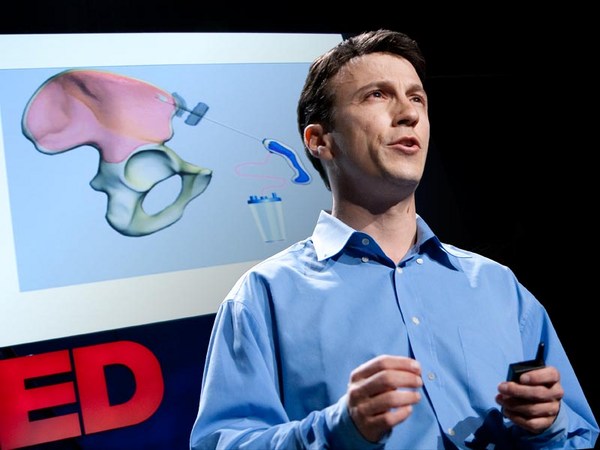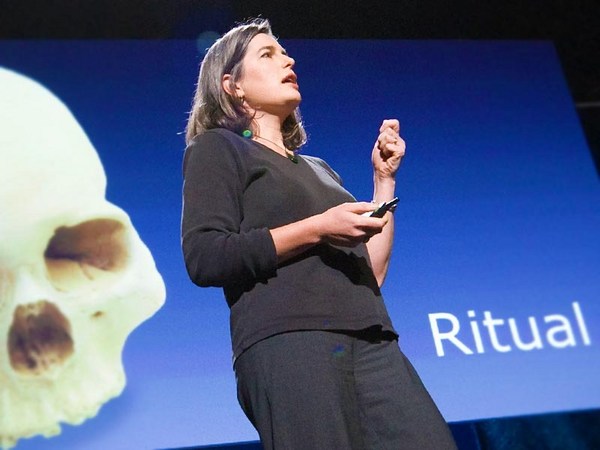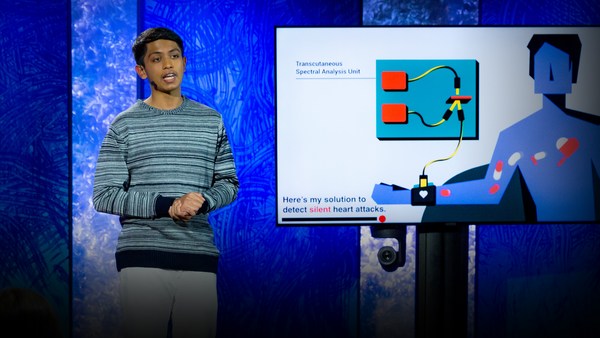A couple of years ago, when I was attending the TED conference in Long Beach, I met Harriet. We'd actually met online before -- not the way you're thinking. We were introduced because we both knew Linda Avey, one of the founders of the first online personal genomic companies. And because we shared our genetic information with Linda, she could see that Harriet and I shared a very rare type of mitochondrial DNA, haplotype K1a1b1a, which meant we were distantly related. We actually share the same genealogy with Ötzi the Iceman. So -- Ötzi, Harriet and me. And being the current day, of course, we started our own Facebook group. You're all welcome to join. When I met Harriet in person the next year at the TED conference, she'd gone online and ordered our own happy haplotype T-shirts.
(Laughter)
Why am I telling you this story? What does it have to do with the future of health? Well, the way I met Harriet is an example of how leveraging cross-disciplinary, exponentially growing technologies is affecting our future of health and wellness -- from low-cost gene analysis to the ability to do powerful bioinformatics to the connection of the Internet and social networking. What I'd like to talk about today is understanding these exponential technologies. We often think linearly. But if you think about it, if you have a lily pad and it just divided every single day -- two, four, eight, sixteen -- in 15 days, you'd have 32,000. What do you think you'd have in a month? We're at a billion. If we start to think exponentially, we can see how this is starting to affect all the technologies around us.
Many of these technologies, speaking as a physician and innovator, we can start to leverage, to impact the future of our own health and of health care, and to address many of the major challenges in health care today, ranging from the exponential costs to the aging population, the way we really don't use information very well today, the fragmentation of care and the often very difficult course of adoption of innovation. And one of the major things we can do is move the curve to the left. We spend most of our money on the last 20 percent of life. What if we could incentivize physicians in the health care system and our own selves to move the curve to the left and improve our health, leveraging technology as well? Now my favorite example of exponential technology, we all have in our pocket. If you think about it, these are really dramatically improving. I mean, this is the iPhone 4. Imagine what the iPhone 8 will be able to do.
Now, I've gained some insight into this. I've been the track share for the medicine portion of a new institution called Singularity University, based in Silicon Valley. We bring together each summer about 100 very talented students from around the world. And we look at these exponential technologies from medicine, biotech, artificial intelligence, robotics, nanotechnology, space, and address how we can cross-train and leverage these to impact major unmet goals. We also have seven-day executive programs. And coming up next month is FutureMed, a program to help cross-train and leverage technologies into medicine.
Now, I mentioned the phone. These mobile phones have over 20,000 different mobile apps available. There's one out of the UK where you can pee on a little chip, connect it to your iPhone, and check for an STD. I don't know if I'd try that, but it's available. There are other sorts of applications. Merging your phone and diagnostics, for example, measuring your blood glucose on your iPhone and sending that to your physician, so they can better understand and you can better understand your blood sugars as a diabetic. So let's see how exponential technologies are taking health care. Let's start with faster. It's no secret that computers, through Moore's law, are speeding up faster and faster.
We can do more powerful things with them. They're really approaching -- in many cases, surpassing -- the ability of the human mind. But where I think computational speed is most applicable is in imaging. The ability now to look inside the body in real time with very high resolution is really becoming incredible. And we're layering multiple technologies -- PET scans, CT scans and molecular diagnostics -- to find and seek things at different levels. Here you're going to see the very highest resolution MRI scan done today, of Marc Hodosh, the curator of TEDMED. And now we can see inside of the brain at a resolution and ability never before available, and essentially learn how to reconstruct and maybe even reengineer or backwards engineer the brain, so we can better understand pathology, disease and therapy. We can look inside with real-time fMRI in the brain at real time. And by understanding these sorts of processes and these connections, we're going to understand the effects of medication or meditation and better personalize and make effective, for example, psychoactive drugs.
The scanners for these are getting smaller, less expensive and more portable. And this sort of data explosion available from these is really almost becoming a challenge. The scan of today takes up about 800 books, or 20 gigabytes. The scan in a couple of years will be one terabyte, or 800,000 books. How do you leverage that information? Let's get personal. I won't ask who here's had a colonoscopy, but if you're over age 50, it's time for your screening colonoscopy. How'd you like to avoid the pointy end of the stick? Now there's essentially virtual colonoscopy. Compare those two pictures. As a radiologist, you can basically fly through your patient's colon, and augmenting that with artificial intelligence, potentially identify a lesion that we might have missed, but using AI on top of radiology, we can find lesions that were missed before. Maybe this will encourage people to get colonoscopies that wouldn't have otherwise.
This is an example of this paradigm shift. We're moving to this integration of biomedicine, information technology, wireless and, I would say, mobile now -- this era of digital medicine. Even my stethoscope is now digital, and of course, there's an app for that. We're moving, obviously, to the era of the tricorder. So the handheld ultrasound is basically surpassing and supplanting the stethoscope. These are now at a price point of what used to be 100,000 euros or a couple hundred-thousand dollars. For about 5,000 dollars, I can have the power of a very powerful diagnostic device in my hand. Merging this now with the advent of electronic medical records -- in the US, we're still less than 20 percent electronic; here in the Netherlands, I think it's more than 80 percent.
Now that we're switching to merging medical data, making it available electronically, we can crowd-source the information, and as a physician, I can access my patients' data from wherever I am, just through my mobile device. And now, of course, we're in the era of the iPad, even the iPad 2. Just last month, the first FDA-approved application was approved to allow radiologists to do actual reading on these sorts of devices. So certainly, the physicians of today, including myself, are completely reliable on these devices. And as you saw just about a month ago, Watson from IBM beat the two champions in "Jeopardy." So I want you to imagine when, in a couple of years, we've started to apply this cloud-based information, when we really have the AI physician and leverage our brains to connectivity to make decisions and diagnostics at a level never done. Already today, you don't need to go to your physician in many cases. Only in about 20 percent of visits do you need to lay hands on the patient. We're now in the era of virtual visits. From Skype-type visits you can do with American Well, to Cisco, that's developed a very complex health presence system,
the ability to interact with your health care provider is different. And these are being augmented even by our devices, again, today. My friend Jessica sent me a picture of her head laceration, so I can save her a trip to the emergency room, and do diagnostics that way. Or maybe we can leverage today's gaming technology, like the Microsoft Kinect, hack that to enable diagnostics, for example, in diagnosing stroke, using simple motion detection, using $100 devices. We can actually now visit our patients robotically. This is the RP7; if I'm a hematologist, I can visit another clinic or hospital. These are being augmented by a whole suite of tools actually in the home now. We already have wireless scales. You step on the scale, tweet your weight to your friends, they can keep you in line.
We have wireless blood pressure cuffs. A whole gamut of technologies are being put together. Instead of wearing kludgy devices, we put on a simple patch. This was developed at Stanford. It's called iRhythm; it completely supplants the prior technology at a much lower price point, with much more effectivity. We're also in the era today of quantified self. Consumers now can basically buy $100 devices, like this little Fitbit. I can measure my steps, my caloric outtake. I can get insight into that on a daily basis and share it with my friends or physician. There's watches that measure your heart rate, Zeo sleep monitors, a suite of tools that enable you to leverage and have insight into your own health.
As we start to integrate this information, we'll know better what to do with it, and have better insight into our own pathologies, health and wellness. There's even mirrors that can pick up your pulse rate. And I would argue, in the future, we'll have wearable devices in our clothes, monitoring us 24/7. And just like the OnStar system in cars, your red light might go on. It won't say "check engine"; it'll be a "check your body" light, and you'll go get it taken care of. Probably in a few years, you'll look in your mirror and it'll be diagnosing you.
(Laughter)
For those of you with kiddos at home, how would you like a wireless diaper that supports your --
(Laughter)
More information, I think, than you might need, but it's going to be here.
Now, we've heard a lot today about technology and connection. And I think some of these technologies will enable us to be more connected with our patients, to take more time and do the important human-touch elements of medicine, as augmented by these technologies. Now, we've talked about augmenting the patient. How about augmenting the physician? We're now in the era of super-enabling the surgeon, who can now go into the body and do robotic surgery, which is here today, at a level that was not really possible even five years ago. And now this is being augmented with further layers of technology, like augmented reality. So the surgeon can see inside the patient, through their lens, where the tumor is, where the blood vessels are. This can be integrated with decision support. A surgeon in New York can help a surgeon in Amsterdam, for example. And we're entering an era of truly scarless surgery called NOTES, where the robotic endoscope can come out the stomach and pull out that gallbladder, all in a scarless way and robotically. This is called NOTES, and it's coming -- basically scarless surgery, as mediated by robotic surgery.
Now, how about controlling other elements? For those who have disabilities -- the paraplegic, there's the brain-computer interface, or BCI, where chips have been put on the motor cortex of completely quadriplegic patients, and they can control a cursor or a wheelchair or, potentially, a robotic arm. These devices are getting smaller and going into more and more of these patients. Still in clinical trials, but imagine when we can connect these, for example, to the amazing bionic limb, such as the DEKA Arm, built by Dean Kamen and colleagues, which has 17 degrees of motion and freedom, and can allow the person who's lost a limb to have much higher dexterity or control than they've had in the past.
So we're really entering the era of wearable robotics, actually. If you haven't lost a limb but had a stroke, you can wear these augmented limbs. Or if you're a paraplegic -- I've visited the folks at Berkeley Bionics -- they've developed eLEGS. I took this video last week. Here's a paraplegic patient, walking by strapping on these exoskeletons. He's otherwise completely wheelchair-bound. This is the early era of wearable robotics. And by leveraging these sorts of technologies, we're going to change the definition of disability to, in some cases, be superability, or super-enabling. This is Aimee Mullins, who lost her lower limbs as a young child, and Hugh Herr, who's a professor at MIT, who lost his limbs in a climbing accident. And now both of them can climb better, move faster, swim differently with their prosthetics than us normal-abled persons.
How about other exponentials? Clearly the obesity trend is exponentially going in the wrong direction, including with huge costs. But the trend in medicine is to get exponentially smaller. A few examples: we're now in the era of "Fantastic Voyage," the iPill. You can swallow this completely integrated device. It can take pictures of your GI system, help diagnose and treat as it moves through your GI tract. We get into even smaller micro-robots that will eventually, autonomously, move through your system, and be able to do things surgeons can't do in a much less invasive manner. Sometimes these might self-assemble in your GI system, and be augmented in that reality.
On the cardiac side, pacemakers are getting smaller and much easier to place, so no need to train an interventional cardiologist to place them. And they'll be wirelessly telemetered to your mobile devices, so you can go places and be monitored remotely. These are shrinking even further. This one is in prototyping by Medtronic; it's smaller than a penny. Artificial retinas, the ability to put arrays on the back of the eyeball and allow the blind to see -- also in early trials, but moving into the future. These are going to be game-changing. Or for those of us who are sighted, how about having the assisted-living contact lens? Bluetooth, Wi-Fi available -- beams back images to your eye.
(Laughter)
Now, if you have trouble maintaining your diet, it might help to have some extra imagery to remind you how many calories are going to be coming at you.
How about enabling the pathologist to use their cell phone to see at a microscopic level and to lumber that data back to the cloud and make better diagnostics? In fact, the whole era of laboratory medicine is completely changing. We can now leverage microfluidics, like this chip made by Steve Quake at Stanford. Microfluidics can replace an entire lab of technicians; put it on a chip, enable thousands of tests at the point of care, anywhere in the world. This will really leverage technology to the rural and the underserved and enable what used to be thousand-dollar tests to be done for pennies, and at the point of care. If we go down the small pathway a little bit further, we're entering the era of nanomedicine, the ability to make devices super-small, to the point where we can design red blood cells or microrobots that monitor our blood system or immune system, or even those that might clear out the clots from our arteries.
Now how about exponentially cheaper? Not something we usually think about in the era of medicine, but hard disks used to be 3,400 dollars for 10 megabytes -- exponentially cheaper. In genomics now, the genome cost about a billion dollars about 10 years ago, when the first one came out. We're now approaching essentially a $1,000 genome, probably next year. And in two years, a $100 genome. What will we do with $100 genomes? Soon we'll have millions of these tests available. Then it gets interesting, when we start to crowd-source that information, and enter the era of true personalized medicine: the right drug for the right person at the right time, instead of what we're doing now, which is the same drug for everybody, blockbuster drug medications, which don't work for the individual. Many different companies are working on leveraging these approaches.
I'll show you a simple example, from 23andMe again. My data indicates I've got about average risk for developing macular degeneration, a kind of blindness. But if I take that same data, upload it to deCODEme, I can look at my risk for type 2 diabetes; I'm at almost twice the risk. I might want to watch how much dessert I have at lunch, for example. It might change my behavior. Leveraging my knowledge of my pharmacogenomics: how my genes modulate, what my drugs do and what doses I need will become increasingly important, and once in the hands of individuals and patients, will make better drug dosing and selection available.
So again, it's not just genes, it's multiple details -- our habits, our environmental exposures. When was the last time your doctor asked where you've lived? Geomedicine: where you live, what you've been exposed to, can dramatically affect your health. We can capture that information. Genomics, proteomics, the environment -- all this data streaming at us individually and as physicians: How do we manage it? We're now entering the era of systems medicine, systems biology, where we can start to integrate all this information. And by looking at the patterns, for example, in our blood, of 10,000 biomarkers in a single test, we can look at patterns and detect disease at a much earlier stage. This is called by Lee Hood, the father of the field, P4 Medicine. We'll be predictive and know what you're likely to have. We can be preventative; that prevention can be personalized. More importantly, it'll be increasingly participatory. Through websites like PatientsLikeMe or managing your data on Microsoft HealthVault or Google Health, leveraging this together in participatory ways will be increasingly important.
I'll finish up with exponentially better. We'd like to get therapies better and more effective. Today we treat high blood pressure mostly with pills. What if we take a new device, knock out the nerve vessels that help mediate blood pressure, and in a single therapy, basically cure hypertension? This is a new device doing essentially that. It should be on the market in a year or two. How about more targeted therapies for cancer? I'm an oncologist and know that most of what we give is essentially poison. We learned at Stanford and other places that we can discover cancer stem cells, the ones that seem to be really responsible for disease relapse. So if you think of cancer as a weed, we often can whack the weed away and it seems to shrink, but it often comes back. So we're attacking the wrong target. The cancer stem cells remain, and the tumor can return months or years later. We're now learning to identify the cancer stem cells and identify those as targets and go for the long-term cure. We're entering the era of personalized oncology, the ability to leverage all of this data together, analyze the tumor and come up with a real, specific cocktail for the individual patient.
I'll close with regenerative medicine. I've studied a lot about stem cells. Embryonic stem cells are particularly powerful. We have adult stem cells throughout our body; we use those in bone marrow transplantation. Geron, last year, started the first trial using human embryonic stem cells to treat spinal cord injuries. Still a phase I trial, but evolving. We've been using adult stem cells in clinical trials for about 15 years to approach a whole range of topics, particularly cardiovascular disease. If we take our own bone marrow cells and treat a patient with a heart attack, we can see much improved heart function and better survival using our own bone marrow derived cells after a heart attack.
I invented a device called the MarrowMiner, a much less invasive way for harvesting bone marrow. It's now been FDA approved; hopefully on the market in the next year. Hopefully you can appreciate the device going through the patient's body removing bone marrow, not with 200 punctures, but with a single puncture, under local anesthesia.
Where is stem-cell therapy going? If you think about it, every cell in your body has the same DNA you had when you were an embryo. We can now reprogram your skin cells to actually act like a pluripotent embryonic stem cell and utilize those, potentially, to treat multiple organs in the same patient, making personalized stem cell lines. I think there'll be a new era of your own stem cell banking to have in the freezer your own cardiac cells, myocytes and neural cells to use them in the future, should you need them. We're integrating this now with a whole era of cellular engineering, and integrating exponential technologies for essentially 3D organ printing, replacing the ink with cells, and essentially building and reconstructing a 3D organ.
That's where things are heading. Still very early days, but I think, as integration of exponential technologies, this is the example. So in closing, as you think about technology trends and how to impact health and medicine, we're entering an era of miniaturization, decentralization and personalization. And by pulling these things together, if we start to think about how to understand and leverage them, we're going to empower the patient, enable the doctor, enhance wellness and begin to cure the well before they get sick. Because I know as a doctor, if someone comes to me with stage I disease, I'm thrilled; we can often cure them. But often it's too late, and it's stage III or IV cancer, for example. So by leveraging these technologies together, I think we'll enter a new era that I like to call stage 0 medicine. And as a cancer doctor, I'm looking forward to being out of a job.
Thanks very much.
(Applause)
Host: Thank you. Thank you.
(Applause)
Take a bow, take a bow.





